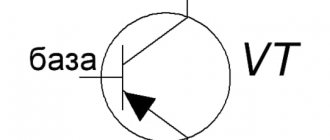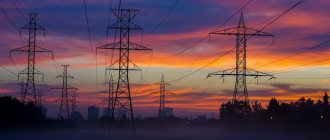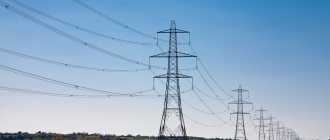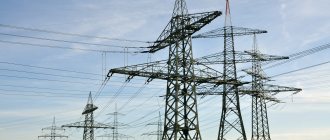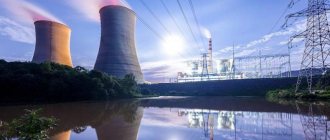When the need for transmitting electricity over long distances first arose, the most accessible material, wood, was first used to build power transmission towers and create long lines. However, a few years later, developers had to look for new material for the construction of power lines.
This was due to a number of disadvantages of wood, including vulnerability to open fire during forest fires, low strength due to insufficient resistance to atmospheric agents and minimal service life.
In the second half of the 20th century, the production of reinforced concrete supports began. The structures turned out to be much stronger, they are not afraid of fire, are resistant to atmospheric precipitation and are more durable.
However, the use of concrete power line supports over time has also shown its inconsistency due to the excessive weight of the structures. This significantly complicated the process of their installation, transportation and subsequent disposal.
As a result, reinforced concrete structures were replaced by modern supports, which began to be made of metal. These products are relatively lightweight, have a long service life and are highly durable. However, to increase the service life and protect the metal from corrosion, they began to hot-dip galvanize lighting poles.
History of the development of power lines
The history of the invention of metal power transmission line supports does not exceed more than one century, since developments in the creation of structures to ensure the transmission of electricity over long distances began in the 19th – 20th centuries. Thus, for the first time, three-phase electricity transmission was carried out in 1891 according to the project of the Russian scientist Dolivo-Dobrovolsky.
Electricity was transmitted at a voltage of 30,000V, the source was a hydroelectric power station with a power of 300 hp, the transmission distance was 178 km.
Later, lines with a voltage of 150 kV were built, and already in 1923 - with a voltage of 220 kV. In the 30s, in Los Angeles, electricity was transmitted over a distance of 155 km at a voltage of 287 kV, the source was the Boulder Dam hydroelectric power station. After this, power transmission was carried out at a voltage of 500 kV from the Volzhskaya HPP named after. IN AND. Lenin to Moscow.
The highest voltage level was 750 kV, energy transmission was carried out in the direction: Konakovskaya GRES - Moscow, Moscow - Leningrad, Donbass - Western Ukraine.
Plus and minus
Today, throughout the world, there is growing interest in direct current power transmission lines (DC power lines), which in some cases have noticeable technical and economic advantages over alternating current power lines of the same power.
Switching to DC is beneficial for many reasons. The costs of building the lines themselves are reduced - replacing three phases with two poles allows you to dramatically reduce the cost of wires or cables. In the case of overhead lines, the supports are structurally simpler and lighter, and the line route is narrower . The consumption of building and structural materials is also noticeably reduced. However, converter substations for DC power lines are more complex and more expensive than AC power line substations, since they contain a lot of additional equipment. These are powerful converter installations with their own regulation, protection, alarm, cooling, etc. systems. Also, substations must have synchronous compensators or powerful capacitor banks to compensate for the reactive power consumed by the converters themselves. Higher harmonic filters, smoothing reactors and other equipment are also installed there.
Point of no return
There is a concept of critical line length. This is the length at which the total cost of DC and AC solutions (substations plus line) is the same. When the line length is greater than the critical one, it is more economically profitable to build a PT transmission line. According to the All-Russian Electrotechnical Institute (VEI), the critical length of an overhead line, depending on the transmitted power and specific geographical conditions, is 600-800 km, a cable line - 30-50 km.
In some cases, direct current is the only option. For example, if you need to connect two AC systems that operate asynchronously or have different frequencies (50 and 60 Hz). In such cases, DC inserts are used.
Also note that the power and length of the AC line are limited by the effects of static and dynamic instability, and the power and length of the DC transmission line are limited only by the parameters of the converter equipment. Moreover, direct current makes the work of the system operator easier: the power transmitted along the DC transmission line can be adjusted very quickly and practically from zero to maximum.
DC transmission lines also reduce the likelihood of serious system failures and facilitate post-disaster restoration of networks. If, if the wire of one phase is damaged, the AC line is switched off entirely, then if the wire of one of the poles of the DC transmission line is damaged, half the power can be transmitted through the wire of the other pole. The ground replaces the damaged wire. Such a regime, which is permissible only for a limited time, usually allows one to maintain the energy supply to consumers of the first category.
Field for implementation
In modern large cities, where the possibility of constructing new overhead lines is limited, “deep penetrations” on DC cables are used. Submarine cable lines operating on direct current can be up to 500 km long. Such solutions using alternating current are impossible in principle due to the increased reactive component of the cable line.
Of course, the prospects for the use of DC transmission lines depend on the overall configuration of the power system. In the 1960s, the situation in the USSR was that the main energy resources of the country were located beyond the Urals, and the electrical load centers were in the European part of the country. It was necessary to transfer large powers over vast distances. At that time, development methods and technologies for constructing classic DC power lines with high-voltage mercury and thyristor voltage converters had already been developed.
In the mid-1960s. In the USSR, a state program was developed, the ultimate goal of which was the creation of a super-powerful (6 GW) direct current power transmission line Ekibastuz - Center with a voltage of 1500 kV (±750 kV relative to the ground). In the project of the 2,400 km long line (it was supposed to be the largest in the world), it was planned at the initial stage to use high-voltage mercury valves to convert the voltage.
Similar mercury valves were used to convert DC voltage to AC voltage
In 1966, the Council of Ministers of the USSR issued a decree on conducting R&D in the field of creating ultra-long DC power lines. The All-Union Electrotechnical Institute was appointed as the leading enterprise for the development of complex electrical equipment for 1500 kV DC power lines. At that time, VEI occupied a leading position in the country and the world in the field of high-power mercury valves and electronic vacuum devices.
However, already in 1970, due to the rapid development of semiconductor converter technology, it was decided to stop developing new powerful mercury valves and in the future focus on thyristor power devices.
Building up the tension
From 1970 to 1980 in the country, electrical equipment complexes were developed for ultra-high-voltage power lines with an alternating current voltage of 1150 kV and a direct current of 1500 kV (±750 kV). The practical implementation of the projects was launched on April 30, 1981 by the joint Resolution of the CPSU Central Committee and the USSR Council of Ministers No. 412. This resolution ordered the USSR Ministry of Energy and Electrification to build and put into operation in 1981-1990. AC power lines with a voltage of 1150 kV Ekibastuz - Kokchetav - Kustanay - Chelyabinsk (1272 km), Surgut - Ural (500 km), Itat - Novokuznetsk (272 km), Novokuznetsk - West Siberian - Ekibastuz (950 km), as well as the already mentioned Power line PT Ekibastuz - Center. Its purpose is to transfer energy from the Ekibastuz State District Power Plant to the Center’s energy system to cover the power shortage in the area. In addition, the task was set to build alternating current power lines with a voltage of 500 kV (with substations) with a total length of about 2 thousand km, necessary for the distribution of electrical energy from substations with voltages of 1150 and 1500 kV.
The Ekibastuz-Center power transmission line project was developed by three organizations: Energosetproekt (lead designer), VEI (developer of electrical equipment) and Direct Current Research Institute (developer of technical requirements for equipment).
According to the project, the rectifier substation was located in Ekibastuz, the inverter substation in Tambov. For the Ekibastuz-Center power transmission line, unique high-voltage thyristor valves, single-phase two-winding converter transformers with a power of 320 MVA for voltage classes ±400 and ±750 kV, and linear reactors were developed, manufactured, tested and partially supplied to the first stage of converter substations (one branch with a capacity of 1500 MW). for voltage class ±750 kV, a series of unified arresters, equipment for control systems, regulation, protection and automation of power lines and other electrical equipment.
Power transmission line support PT Ekibastuz - Center, installed for crossing the Volga
The commissioning of the DC line, postponed to 1992-1995, did not take place due to the collapse of the USSR. By 1991, an overhead power line almost 1000 km long had been built, installation of electrical equipment began at the converter substations, but soon all work was stopped. The electrical equipment was dismantled, the power lines were dismantled and sold as scrap.
Today, only the remaining isolated structures here and there remind us of the grandiose Soviet project. For example, in the Volsk region (Saratov region), giant 124-meter supports installed to cross the Volga carry the wires of the 500-kilovolt alternating current power line Balakovo NPP - Kurdyum - Frolovo.
* * *
According to VEI specialists, electrical equipment for direct current lines with a voltage of 1500 kV, created in the USSR, was about 20 years ahead of foreign developments. The first transmission line of this class (±800 kV) was put into operation in China only in 2010.
Source: Energovector
The highest power lines
The tallest power transmission line support in Russia was included in the Russian Book of Records, and there were two such structures. They are located in Kaliningrad on the banks of the river. Pregolya. Interestingly, these structures are presented in the form of sea anchors.
The implementation of the unique project was undertaken by the electric grid company, which is part of PJSC Rosseti. It is important to note that we are now also talking about the tallest power transmission towers in the world.
The anchor-shaped structures symbolize the sea gates that open the way to the Kaliningrad region. The height of the largest Russian supports is 112.066 m.
Considering that the height of the structures presented in the fall of 2018 is comparable to a 36-story building, the question arises of how much the power line support weighs. The weight of one structure is 450 tons, the width of the anchors exceeds 16 meters. These monumental structures, each with five tiers, can withstand wind gusts of up to 36 m/sec.
This is due to the reliability of the structure, which is ensured by more than 270 piles buried 24 m into the ground. Signal lighting is provided on the supports, which are turned on mainly at night for aircraft and ships.
The manufacture of supports was carried out by specialists from Opytny, and the installation was carried out by employees. It is worth noting that the wire above the surface of the sea surface is raised almost 69 meters.
This was done to ensure the free passage of the sailing ships “Kruzenshtern” and “Sedov” with mast heights above the deck of 55 and 58 meters, respectively.
The company clarified that anchors are not the only stylized power line supports that were installed in the Kaliningrad region. Thus, a stylized support was also installed for the 2022 FIFA World Cup.
Since several championship games were held in Kaliningrad, it was decided to install a power line support in the shape of a wolf “Zabivaki”.
Northern Current: the longest superconducting power line will be built in St. Petersburg
The world's longest superconducting power line will be launched in 2022 in St. Petersburg. The system is based on a cable made of bismuth and silver, which will have dual-circuit cryogenic cooling and automatic control. Its use will minimize space for infrastructure construction in the historical center of the city, and will also reduce losses during energy transmission. The success of the project could become a landmark event in the electric power industry, after which there will be an explosive increase in efficiency due to the introduction of new materials, experts say. The work will be performed by the Federal Grid Company of the Unified Energy System (FSK UES). The cost of construction will be 3.5 billion rubles.
Cold circuit
Laying cables from superconducting materials is the most advanced method of transmitting electricity, which virtually eliminates its losses. However, due to the technical complexity and high cost of power lines of this type, until now they have not had a significant length, which limited the range of tasks solved with their help. The project to create a new superconductor line in St. Petersburg - it will have a record length of 2.5 km - can change the view on innovative energy.
Power line collapse in St. Petersburg caught on video
“During construction, we will use a high-temperature superconductor Bi2223/Ag made of bismuth and silver, which is made in the form of a 4 mm wide strip,” said a developer from the Scientific and Technical Center of FGC UES. — It achieves the required properties at a boiling point of liquid nitrogen of 77 °K (-196 °C), which makes it necessary to use a powerful cooling system.
The engineers decided to make the system a dual-circuit system - the first will contain helium gas, which is necessary for cooling liquid nitrogen. It will circulate in the cable itself and in the return line (cryostat), providing the superconductor with an operating temperature. Thus, the total length of the second circuit will be twice the length of the power line and will be about 5 km.
The innovative line will be equipped with an automatic control system, which will be responsible for maintaining the operating mode of all components, as well as displaying the necessary information on the operator’s console. From there, the specialist will be able to monitor the situation and intervene if necessary.
Izvestia Help
Superconductivity is a state of materials in which they have strictly zero electrical resistance. This phenomenon, discovered in 1911, is of a quantum nature and is characterized by the complete displacement of the magnetic field from the conductor (Meissner effect).
It is possible to achieve its manifestation only at extremely low, cryogenic temperatures. This still limits the use of superconductors to the production of powerful magnets, which are used in medical tomographs, particle accelerators and some electric motors. At the same time, scientists are approaching the problem of transporting energy through superconducting cables only now - as they solve problems with cooling long lines and the safety of their use.
Ligovsky option
It is planned that the new power line will connect the substations, which are located in the center of St. Petersburg (near Ligovsky Prospekt). According to developers, in this area, growing energy consumption is combined with the difficulty of building additional infrastructure that may not fit into the historical appearance of the city. That is why it was decided to lay a superconducting cable underground, which is capable of transmitting 50 megawatts of power at an average voltage of 20 kilovolts.
On a bright path: a way has been found to overcome the pitch darkness on the roads
Ministries and regions sent their proposals for financing the project to the government
“This approach allowed us to abandon the alternative option of creating several standard lines, which would have required the use of a larger volume of city resources,” explained the Scientific and Technical Center of FGC UES.
In addition, the use of a superconductor was preferable from an environmental and safety point of view due to its lower voltage class.
According to the construction plan, only fragments of the cooling system will be left in the above-ground part of the complex, which will be located in a separate building and in an open area located on the territory of the Tsentralnaya substation.
Show example
The relevance of using superconductors to create power lines was emphasized in innovative.
Powerful reserve: why optimization of energy tariffs is needed
The cost of transmitting electricity over networks for businesses may decrease by 6%
“The presented solution is relevant both for St. Petersburg and for any other metropolis where it is impossible to allocate additional space for an overhead power line,” says leading researcher Vladislav Kalitka. “Especially when laying a large collector for standard cooling of traditional underground cables will not require too much expense.
According to the expert, installing a superconductor will not require such large-scale excavation work and may become a more economical solution in terms of operation.
Experts also spoke about the safety of using the new solution.
“The introduction of these materials is facilitated by progress in the field of switching equipment, the speed of which has increased significantly in recent years,” said Vladimir Tulsky, director of the Institute of Electric Power Engineering at the Moscow Energy Institute. “This will allow you to quickly disconnect the line in the event of an emergency, which in the case of superconductors can result in a powerful explosion (if the power is not removed in a timely manner).
Ice and fire: metal “burning” in cold water will warm the Arctic
A new environmentally friendly method for producing energy from magnesium and aluminum has been developed
At the same time, experts emphasize that the experience of operating a new power transmission line in St. Petersburg can cause radical changes in the entire industry.
“The construction of a superconducting line of record length can become a landmark event in the electric power industry, which will open up opportunities for more active use of new materials,” says General Director Alexander Katsai.
According to him, in this case, engineers will be able to significantly increase the efficiency of the infrastructure, since they will need significantly fewer cables and transformers to transmit electricity.
As part of R&D for the new project, the developers successfully carried out a set of tests. Their list included analysis of the electrical properties of the cable, checking the service life of the cooling system, as well as testing the necessary protective interlocks to ensure the safety of its use.
It is expected that the innovative power transmission line will be introduced into the energy system of St. Petersburg in 2022 and will become the longest superconducting line in the world. Currently, the plan for its creation has already been included by the Russian Ministry of Energy as part of the national project. The total investment in construction will be 3.5 billion rubles.
Order galvanizing of power transmission line parts from Tochinvest Zinc
By cooperating with our company, clients receive a number of obvious advantages:
- The company's capacity is 120,000 tons per year, which guarantees prompt completion of assigned tasks, regardless of volume and complexity.
- We have been working since 2007, during which time we have prepared and equipped 3 hot-dip galvanizing workshops.
- The company is the owner of the deepest bathtub in the Central Federal District - 3.43 meters, so we can process various dimensional structures.
- The production is equipped with modern equipment from the Czech company EKOMOR and the German-Austrian company KVK KOERNER.
- Processing of parts using hot-dip galvanizing technology is carried out taking into account the requirements of GOST 307-89.
You can find out more about the timing of the work and the cost of galvanizing by calling the numbers listed on the website.
All types of galvanizing carried out have a 100% guarantee. Return to articles Share article
The world's longest power lines
High-voltage direct current (HVDC) has emerged as the preferred transmission technology for international wholesale power supply. Brazil and China each have two of the world's longest power transmission lines.
Belo Monte - Rio de Janeiro, Brazil - 2,543 km
The 2,543 km Belo Monte-Rio de Janeiro transmission line in Brazil is an 800 kV ultra-high voltage direct current (UHVDC) line that transmits electricity from the 11.2 GW Belo Monte hydroelectric power plant located in Para Rio de Janeiro, Brazil .
Construction of the transmission line, which is also known as the Belo Monte UHVDC Bipole II line, began in September 2022 and was completed in April 2022. The overhead power line, which has transmission towers 105m and taller, crosses 80 cities along its route from the Amazon to the southeast coast of Brazil. The line has two power converter stations and is capable of transmitting 4 GW of electricity.
The Belo Monte-Rio de Janeiro transmission line was built by the State Grid Corporation of China (SGCC) as part of China's Belt and Road Initiative (BRI). This is the second 800 kV UHVDC line to be built and operated by SGCC in Brazil, following the Belo Monte UHVDC Bipole I line, which was completed at the end of 2022.
Rio Madeira transmission link, Brazil - 2,385 km
The Rio Madeira transmission line in Brazil is a 600 kV high-voltage direct current (HVDC) line that entered service in November 2013. It is capable of transmitting 7.1 GW.
The Rio Madeira HVDC link transmits electricity from the Santo Antônio and Jirau hydroelectric dams on the banks of the Madeira River in northwest Brazil to major load centers in southeast Brazil. It connects the Porto Velho collector substation in the state of Rondonia with the Araraquara 2 substation in the state of São Paulo.
The HVDC transmission line was built in 24 months by Interligação Elétrica do Madeira (IE Madeira), a consortium of three large Brazilian energy suppliers. ABB supplied power equipment for three HVDC stations. Alstom supplied two double-pole HVDC converter stations and four HVDC power converter transformers for the project.
Jinping-Sunan Power Transmission Line, China - 2,090 km
The Jinping-Sunan transmission line in China is an 800 kW UHVDC transmission line. Owned by the State Grid Corporation of China (SGCC), the 7.2 GW transmission line came online in December 2012.
The line crosses eight Chinese provinces to transmit electricity generated by the Guangdi, Jinping and Sichuan hydroelectric dams, located on the Yalong River in the central-western province of Sichuan, to the industrialized coastal area of Jiangsu province in East China. The AC voltage at both ends of the line is 525 kV.
The transmission project was approved by the government in November 2008 and involved an investment of approximately 22 billion yuan ($3.5 billion). ABB developed and designed the project together with SGCC and local Chinese partners. ABB also supplied key project components, including 800 kV UHVDC electrical transformers for both converter stations.
Xiangjiaba-Shanghai Power Line, China - 1,980 km
Xiangjiaba-Shanghai transmission line, with an overhead length of 1.980 km, 800 kV, 7.2 GW line owned by SGCC. The world's first UHVDC transmission line began commercial operation in July 2010.
The Xiangjiaba-Shanghai connection transfers power from the Xiangjiaba hydroelectric power station located in Southwest China to the country's main industrial and commercial center, Shanghai. The line consists of one overhead line and 28 HV/UHV converters. The AC voltage at both ends of the line is 525 kV.
The UHVDC transmission project was approved by the government in April 2007 and completed 30 months later. ABB, under a turnkey contract, provided the overall design of the system, in addition to supplying key components such as high and ultra high voltage transformers, thyristor valves, AC and DC switchgear and HVDC control system.
Inga-Kolwezi power line, Congo – 1700 km
The 1,700 km Ingo-Kolwezi transmission line, formerly known as the Inga-Shaba line, is a 500 kV line with a rated capacity of 560 MW. It is owned and operated by the national energy company of the Democratic Republic of the Congo (DRC), Société Nationale d'Electricité (Snel).
The Inga-Kolwezi HVDC line supplies electricity from the Inga Falls hydroelectric dam on the Congo River to the Katanga copper mining area in south-eastern Congo. Commissioned in 1982, it was the world's longest power transmission line at the time. The AC voltage at both ends of the line is 220 kV.
Key components for the project, including converter stations, were supplied by ABB, which was also awarded the contract to refurbish the line with new thyristor valves, new high-voltage equipment and a new control and protection system to improve the efficiency and reliability of the line in 2009.
Talcher-Kolar power transmission line, India - 1450 km
Talcher-Kolar 500 kV HVDC transmission line is also known as East-South transmission line. It has a rated power of 2500 MW. Owned by Power Grid Corporation of India, Talcher-Kolar was the second longest transmission line in the world at the time of its commissioning in February 2003.
The Talcher-Kolar Transmission Line carries electricity from the Talcher Power Generation Center in the eastern Indian state of Orissa to the city of Kolar near Bangalore, the capital of the southern state of Karnataka. At the time of commissioning, the two-pole transmission line was capable of transmitting 2000 MW of electricity, but in 2007 it was upgraded to 2500 MW. Siemens built the converter stations for the Talcher-Kolar HVDC connection.
Power Grid Corporation of India is also building India's first UHVDC transmission line, the 1,728 km 800 kV North-East Agra UHVDC link, which is capable of transmitting 8,000 MW. The project is being implemented by ABB. This will be the longest transmission line in India once commissioned.

